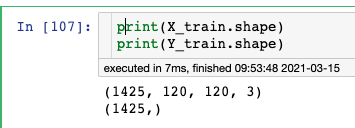I'm training a standard CNN. Attached my training curve. My model:
Model: "functional_35"
_________________________________________________________________
Layer (type) Output Shape Param #
=================================================================
input_18 (InputLayer) [(None, 120, 120, 3)] 0
_________________________________________________________________
conv2d_28 (Conv2D) (None, 118, 118, 32) 896
_________________________________________________________________
max_pooling2d_28 (MaxPooling (None, 59, 59, 32) 0
_________________________________________________________________
dropout_23 (Dropout) (None, 59, 59, 32) 0
_________________________________________________________________
flatten_17 (Flatten) (None, 111392) 0
_________________________________________________________________
dense_17 (Dense) (None, 256) 28516608
_________________________________________________________________
visualized_layer (Dense) (None, 1) 257
=================================================================
Total params: 28,517,761
Trainable params: 28,517,761
Non-trainable params: 0
_________________________________________________________________
My data dimension:
Is my model overfitting, if so, what's my best strategy now?


